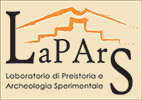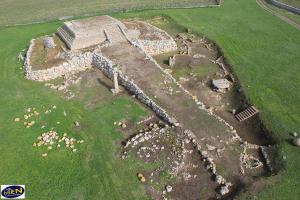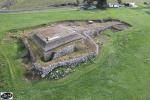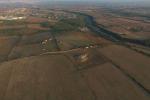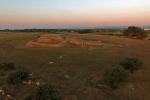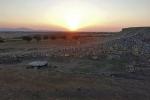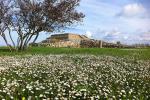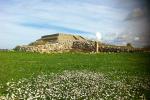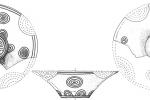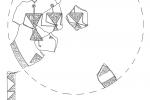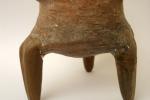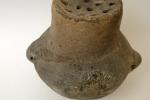Monte d’Accoddi
The Prenuragic sanctuary of Monte d'Accoddi is among the most important architectural demonstrations of the Mediterranean prehistory. The previous studies have defined the monument like an altar, a ziggurat, a temple or a step pyramid. Perhaps this site represents as fully the Sardinian Prehistory, both because it was continuously frequented by medium Neolithic to Early Bronze Age, and then it contains the most significant elements of tradition and innovation during the passage since Neolithic to Eneolithic. These factors are evident in architecture, in cultural aspects and in the handicraft production. A full debate has been generate about the hypothetical genetic relationship, the reconstructive hypothesis and the meaning. This project does not analyse the previous topics, but it draws attention about other problems that are controversial like chronology or aspects that are not deeply studied like craft production.
With this in mind finds recovered from many years of excavation conducted by Ercole Contu in the 1950's are being examined. The first studies not only showed the most important architectural aspects of the monument, but they have also underlined the frequentation of the site from the Neolithic to the early Bronze Age.
New radiocarbon dating resulting from sites in the south of Sardinia and recent data that has been published about craft production relating to the shrine, allow us to date the building of the first monument (4000-3650 cal. BC) to the Ozieri facies, with the second shrine dated the Sub Ozieri (3500-3000 cal. BC) facies. The analysis of craft production and chronological data demonstrate a constant evolution without sudden changes. This evolution is linked to a slow transformation of the socioeconomic organisation. The preliminary results of the study of the finds shows that they were implemented in domestic and ritual activities, related to the use of ochre, to spinning and weaving, to agriculture and metallurgy. The menhir, the stelae and the marble statuettes all recall aspects of the symbolic characteristics of Sardinian Neolithic and Eneolithic traditions.
THE CHRONOLOGICAL/CULTURAL SEQUENCE
Late Neolithic. San Ciriaco. Settlement
After an initial moment of confusion, originating in the still somewhat unclear cultural reference points of San Ciriaco, today it is possible to retrace a reasonable quantity of ceramic finds to this period. These were found in various areas around the monument, mostly in the lower deposits (7 and 8), but also in the middle layers (4 and 5) of Contu's excavations. Many finds were recovered roughly 200 m to the east of the monument in the "ETFAS" trial trench.
Final Neolithic. Ozieri. Settlement. The first phase of the ramped monument
At Monte d'Accoddi the Ozieri ceramic finds seem to be particularly abundant, partly because they are easily recognised among small fragments, thanks to their distinctive decoration. The discovery of pottery from that facies in the building and frequentation layers of Monument I is to be considered a terminus ad quem, which dates the monument in its earliest phase.
Early Eneolithic. Sub-Ozieri. Settlement. The second phase of the ramped monument
The discovery of pottery from that facies in the building and frequentation layers of Monument II is to be considered a terminus ad quem, which dates the monument in its second phase.
The older monument was enclosed by a larger building, built of polygonal masonry.
Medium Eneolithic. Filigosa. Settlement.
During the middle phase of the Eneolithic (first half of the III millennium BC) there is evidence of frequentation of the shrine, demonstrated by the presence of pottery from that period.
Medium and late Eneolithic. Abealzu, Monte Claro. Settlement.
During the Abealzu phase the village developed to the east of the monument, and included the so-called "hut of the sorcerer", which contains the only sealed context attributable to the Abealzu. The presence of a hut placed at the base of the ramp suggests that access to the upper part of the building was controlled and limited in this period. In the same period there is also the sporadic appearance of elements belonging to the Monte Claro facies.
Final Eneolithic and Early Bronze Age. Bell-Beaker, Bonnanaro.
During the final phases of the Eneolithic the shrine was occasionally visited by Bell-Beaker bearing groups or individuals. Finally, during the Early Bronze Age the burial of a young male replete with grave goods took place: the skull of the young man was placed inside a tripod with handles alongside a spherical bowl.
